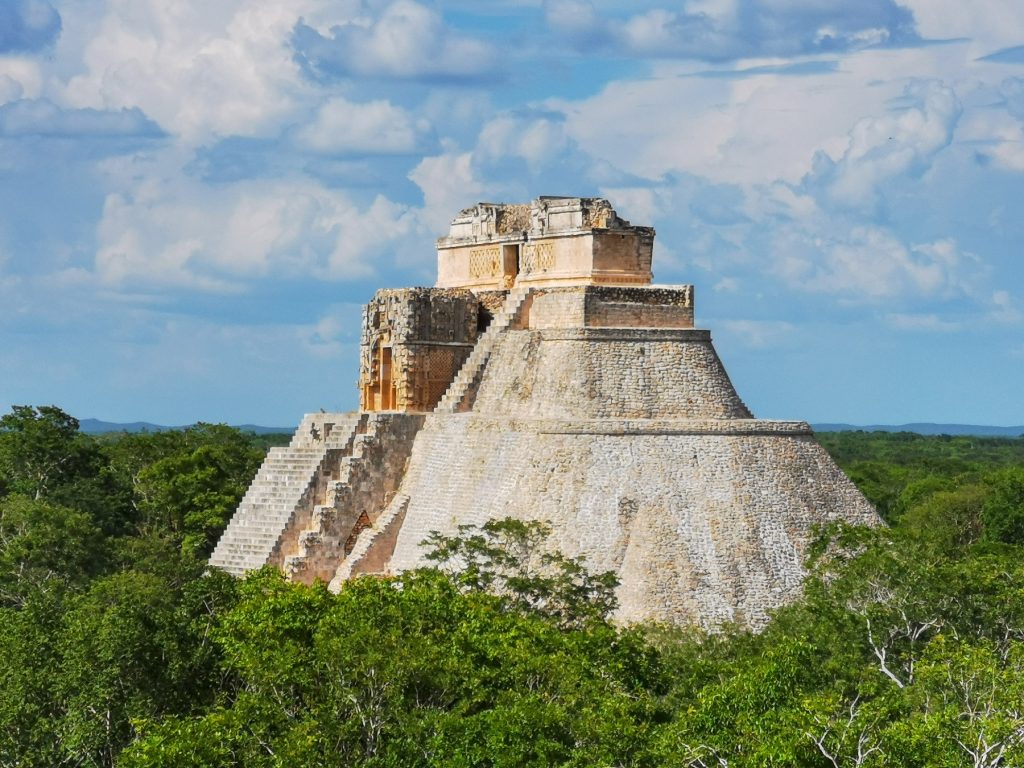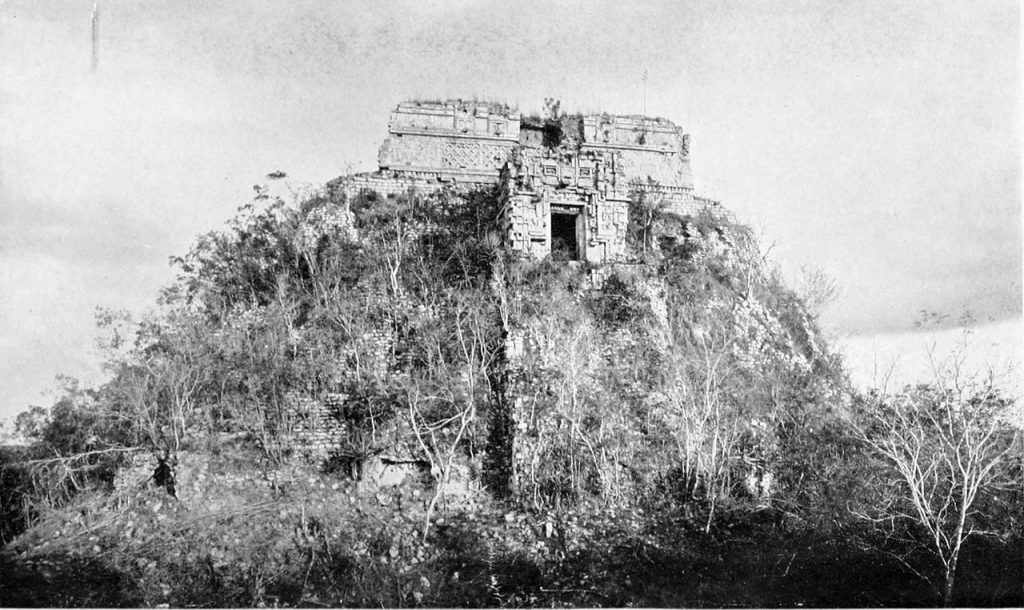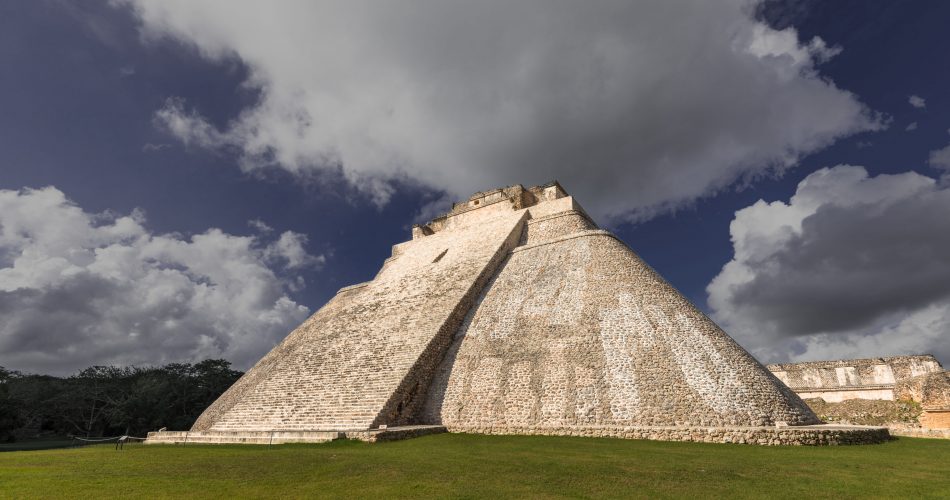- The Pyramid of the Magician is the tallest structure at Uxmal and is essentially a five-step pyramid.
- Legends say that the pyramid was built by means of magic in one day by a Dwarf King. However, the pyramid most likely took several decades to be built. Various architectural styles are embedded within the structure.
- The ancient city of Uxmal was one of the most important Maya cities in the Yucatan region. The ancient city is home to two pyramids and various temples, plazas and a ball court.
The ancient Maya civilization was one of the most proliferate pyramid-building cultures in the history of mankind. This ancient civilization inhabited parts of the Yucatan Peninsula, and Central America, building incredible, vast cities fitted with intricate observatories, temples, plazas, and pyramids. One of their most beautiful examples is the Pyramid of the Magician in the ancient city of Uxmal.
Thought to have been built around 560AD, the Pyramid of the Magician is a Step Pyramid and one of the tallest structures in the city of Uxmal. The structure is also known as the Pyramid of the Dwarf and the Pyramid of the Prophet / Sootsayer. (La Piramide del hechicero, del enano o del gran Chilán)
The city of Uxmal is considered one of the most important archaeological sites of the ancient Maya together with other great cities such as Palenque, Chichen Itza, Calakmul, Caracol, Tikal, and Xunantunich. Founded in the eastern parts of the Yucatan Peninsula, the city of Uxmal is regarded as one of the most representative cities of Mayan architectural dominance in the region. Uxmal’s present name is believed to derive from the ancient Maya word ox mal which is translated into “three times built”. It is believed that the name of the city suggests that the city was rebuilt in antiquity on several occasions.
However, some experts in the Maya world believe that another possibility is the world Uchmal which means what is to come. According to mythology, the city of Uxmal was an invisible city that had been built by means of “magic” in one night by a dwarf king. Whatever the case, it is one of the most relevant Maya cities in the Yucatan peninsula.
It is home to not only massive buildings that are incredibly-well decorated, but the city also features pyramids and ancient roads called sacbes that connect the most important structures in the city.
The architects of the city of Uxmal knew how to take advantage of the terrain and built some of their most important buildings on elevated terrain in order to make the structures appear larger. The Pyramid of the Magician has five levels, and the structure known today as the Governor’s palace covers an area of more than 1,200 m2 (12,917 sq ft).

Built to a height of around 35 meters, the pyramid’s construction is shrouded in myths. According to the accounts of John Lloyd Stephens, in his book 1841 book, Incidents of Travel in Central America, Chiapas, and Yucatan, “the Pyramid was constructed in no more than one night by a powerful dwarf who had “hatched” from an egg which was found by a powerful witch near the city of Uxmal. The dwarf child was born and had the ability to foresee the future,” the reason why many people refer to the pyramid as the Pyramid of the Prophet or Soothsayer.
The legend says that one day “the dwarf discovered a tunkul (a kind of wooden percussion instrument) and began to play it. According to the prophecies, it was known that when someone played that instrument and its sound reverberated throughout the region, the one who played the instrument would gain the throne of the city, so when it was heard by the king of Uxmal, he identified the sound as the announcement of the end of his reign.
Ready to face his fate, the king called the dwarf to submit him to several difficult tests that the young man successfully passed. Finally, he survived the most difficult one: breaking over his head, with a stone mallet, a basket of cocoyoles (a kind of very hard fruit). The King of Uxmal underwent the same test as punishment and died instantly after the first blow. Thus began in Uxmal the reign of the dwarf prophet, the man who had hatched from an egg, found by a Witch near Uxmal. This fortune-telling dwarf would supposedly build the pyramid in one day.

However, archaeologists have clarified that the unusual elliptical shape of the pyramid (unique in its kind in Mayan architecture) is the result of several successive construction phases; what we see today is the result of five different pyramidal temples with their own levels and styles among which are the Petén, Usumacinta, Chenes, and Puuc styles. This wasn’t uncommon for the Maya. Their architects are known for superimposition in the construction pyramids; the Maya are thought to have gradually increased the dimension of structures by building newer buildings on top of existing ones. As explained earlier, the Pyramid of the Magician is, in fact, the result of five superimposed temples.
Evidence that the Pyramid was built in various phases can be found in the heart of the pyramid. Temple I of the pyramid is located at ground level. Its decoration is based on columns and Chaac masks, among which two above the entrance stand out. It is in this temple where archeologists found the sculpture of the “Queen of Uxmal”: the head of a snake with an open mouth from which a human being emerges.
To build temple two, which is at a height of about 2/3 of the current one, it was necessary for ancient Maya architects to cover Temple I and build a pyramid on it. To access it, an opening was made from where the columns supporting the roof can be seen. Phase III or Temple III is not visible from the outside at all: it was built onto the rear of Temple II and consists of a small central shrine and an antechamber. Temple IV can be accessed from the western side and features the most intricate decorations of the pyramid. Constructed in the so-called Chenes style, the facade of the temple is a representation of the masks of Chaac, whose jaws serve as the door.
Being the most decorated part of the pyramid, the temple is covered with beautiful masks representing the rain god and lattice ornamentation. Both upper temples are influenced by the Chenes architectural style. Temple V is the final part of the pyramid and is known as the House of the Magician. It marks the summit of the pyramid and dates back to around the ninth century. This structure is composed of three distinct chambers.
There are other pyramid-temples and monuments at Uxmal of significant size in various states of preservation. One such structure is the so-called Great Pyramid. The Great Pyramid at Uxmal is one of the few large Mayan buildings that tourists can still climb. It has nine superimposed bodies and a staircase to the north. At its prime, the pyramid may have been of similar size to the pyramid of the Magician. This structure measures around 80m on its north side and is approximately 30m high. Its general shape is that of a truncated quadrangular pyramid.
Also called the Temple of Macaws (Templo de guacamayos), the pyramid is thought to have been built in the eighth century. It is decorated by numerous bird-motifs. The corners of the Temple have three Chac masks.

